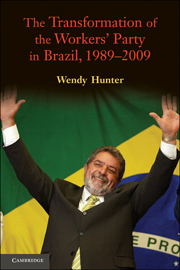Book contents
- Frontmatter
- Contents
- Tables, Charts, and Figure in Text
- Tables and Chart in the Appendix
- Acronyms
- Acknowledgments
- 1 Introduction: Understanding the Normalization of the Workers' Party
- 2 Strategic Change or Organizational Persistence? Evolution of the Workers' Party
- 3 Opposition Politics: The PT in the Chamber of Deputies
- 4 The PT in Municipal Government: The Pragmatic Face of the Party
- 5 Striving for the Presidency: From Opposition to Government
- 6 New Challenges and Opportunities: The PT in Government, 2003–2009
- 7 Analytical Implications and Comparative Perspectives
- Appendix
- References
- Interviews
- Index
1 - Introduction: Understanding the Normalization of the Workers' Party
Published online by Cambridge University Press: 05 June 2012
- Frontmatter
- Contents
- Tables, Charts, and Figure in Text
- Tables and Chart in the Appendix
- Acronyms
- Acknowledgments
- 1 Introduction: Understanding the Normalization of the Workers' Party
- 2 Strategic Change or Organizational Persistence? Evolution of the Workers' Party
- 3 Opposition Politics: The PT in the Chamber of Deputies
- 4 The PT in Municipal Government: The Pragmatic Face of the Party
- 5 Striving for the Presidency: From Opposition to Government
- 6 New Challenges and Opportunities: The PT in Government, 2003–2009
- 7 Analytical Implications and Comparative Perspectives
- Appendix
- References
- Interviews
- Index
Summary
In 1989, a scruffy bearded figure calling for radical change under the symbol of his party's red star competed in Brazil's first open and direct presidential election in almost thirty years. The candidate was Luiz Inácio Lula da Silva from the Partido dos Trabalhadores (PT, or Workers' Party). After a campaign marked by intense political polarization, Lula's narrow defeat to his right-wing competitor Fernando Collor de Mello came as a major relief to conservative sectors of Brazilian society. The specter of a PT-led government prompted the formation of a center-left alliance that would effectively keep the PT in the opposition for years to come. Finally in 2002, after winning progressively greater first-round vote shares in every presidential election since 1989, a more moderate and smartly coiffed Lula led the PT to victory in a presidential campaign that took place in an atmosphere of comparative political stability and consensus. He won reelection by a wide margin in 2006.
Between Lula's first unsuccessful run for the presidency in 1989 and his eventual victory in 2002, the PT became a leading contender at other levels of Brazilian politics as well. Featuring an active legislative delegation that expanded in every successive election, the PT eventually constituted the largest bloc in the lower house of Congress. While its legislators debated issues of national importance, PT mayors won office and governed in an increasing number and array of Brazil's cities.
- Type
- Chapter
- Information
- Publisher: Cambridge University PressPrint publication year: 2010

